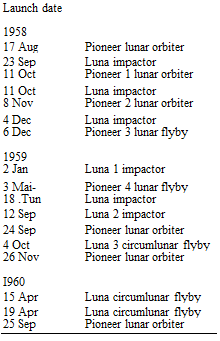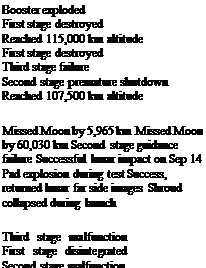Breaking free of Earth
TIMELINE: AUG 1958-SEP 196ft
The space age began on October 4, 1957, with the launch of Sputnik during a test flight of Korolev’s new R-7 launcher. The ignition of the rocket’s engines on the pad in Baikonur on that day was the explosion that opened the floodgates of space exploration. A little over ten months later, on August 17, 1958, the first attempt was made to send a spacecraft to the Moon, a tiny orbiter, and this time launched by the US, but the rocket exploded. On September 23, the USSR attempted to send a lunar impactor to the Moon using a new variant of the R-7 augmented with a small third stage to reach escape velocity. The booster failed and was destroyed. The race to the Moon and planets was on.
In the three years 1958-1960, the US attempted nine times to send a small Pioneer class spacecraft to the Moon. All failed in one way or another. In the two years 1958-1959, the USSR also attempted nine times to send a spacecraft to the Moon. Of these, six were lost to launch vehicle failures, the Luna 1 impactor missed the Moon by 6,000 km, Luna 2 succeeded in impacting the Moon, and Luna 3 traveled beyond the Moon and sent back grainy pictures of its hitherto mysterious far side.
THE YE-1 LUNAR IMPACTOR SERIES: 1958-1959
Campaign objectives:
After the launch of Sputnik, Korolev took advantage of the world’s reaction to push the Soviet government into approving plans for non-military applications of his R-7 rocket, including lunar exploration. An earlier attempt in 1955 had been of no avail, but now’ the time was ripe. He established three new design groups at OK. B-1, one for
W. T. Huntress and M. Y. Marov, Soviet Robots in the Solar System: Mission Technologies and Discoveries, Springer Praxis Hooks 1, DOl 10.1007/978-1-4419-7898-1 6,
© Springer Science+Business Media, LLC 2011
 |
 |
communications satellites, one for manned space flight, and the third for robotic lunar spacecraft. Mikhail Tikhonravov and Gleb Maksimov were in charge of the latter. Mstislav Keldysh provided specific scientific goals. After a few months work, Korolev and Tikhonravov sent a letter to Moscow on January 28, 1958, proposing a lunar impactor and a lunar flyby mission to photograph the far side. Korolev and Keldysh jointly convinced the government, and on March 20 approval was granted. In fact, lunar spacecraft designs were underway and in February Korolev had begun to develop the third stage required for his R-7 launcher. He was very aware of well – publicized plans in the US for a lunar orbiter to be launched in the summer of 1958, and he wanted to be first.
While preparing for the launch of the first spacecraft to the Moon in the summer, Korolev and Tikhonravov expanded the scope of their plan for the conquest of space by the Soviet Union. This plan was finished in early July 1958, but was held secret outside of a few people in the closed Soviet space circle. It called for upgrading the R-7 to three stages to launch robotic lunar landers and photographic flyby missions, then upgrading the R-7 again to four stages to launch spacecraft to Mars and Venus, and developing orbital rendezvous and other techniques and technologies to enable men to fly around and land on the Moon, as a precursor to creating a colony on the Moon and visiting Mars and Venus.
Maksimov and Tikhonravov also prepared detailed designs for five types of lunar spacecraft in the spring of 1958:
Ye-1 Lunar impact spacecraft, 170 kg
Ye-2 Lunar Гаг-sidc photographic flyby, 280 kg
Ye-3 Same as Ye-2 with improved photographic equipment
Ye-4 Lunar impact spacecraft with explosives, possibly nuclear, 400 kg
Ye-5 Lunar or biter
The Soviets were concerned about proving that their spacecraft had hit the Moon, not recognizing at first that they could be tracked by any other country with the right equipment. Telemetry cessation was not definitive and so the notion was considered of exploding a device on the Moon for all to see, hence the Ye-4 with sufficient payload capacity to carry a nuclear or a large conventional explosive. Korolev was reluctant to use a nuclear explosive, and after consultation with recognized nuclear physicist Yakov Zeldovich and several other physicists this idea was dropped. The Ye-4 itself was eventually abandoned as the technical and political problems became clear, and tracking was recognized as the solution. Even so, the Ye-1 third stage was outfitted with a device to release a sodium cloud for optical tracking and for general observation around the world. The Ye-5 lunar orbiter project was canceled when the new7 8K73 rocket which w7as to launch it suffered engine development problems and was itself canceled.
As the summer of 1958 arrived, Korolev rushed to launch his first lunar impactor before the date set by the Americans for their tiny orbiter. Although he was having technical problems with his first three-stage vehicle, he decided to take the risk and readied his R-7 on the same day as the Americans, but stood down w’hen he learned that the IJS rocket had exploded. But the extra time w as of no avail, and one month later his launch vehicle also exploded after a short flight. Ко matter, the space race was on and its public characteristics were now’ well defined.
In the Soviet program, planning and launch information were held secret and only successful launches reported. Spacecraft that were launched successfully but failed in their objectives had their missions redefined in the Soviet press to make all appear successful. By contrast American plans were announced well in advance, and open to press and public scrutiny. It made for a dramatic contest on each side; one well aware of the other’s plans and proceeding to blind-side its competitor, and the other mostly unaware of the other’s plans and groping almost blindly to seize and retain a leading position.
Six Ye-1/1A spacecraft were launched in the 12-month period between September 1958 and 1959. Only two. Luna 1 and 2. escaped launch vehicle mishaps. Luna 1 and its flight past the Moon wras a sensation to match that of Sputnik almost a year earlier. The Soviet press referred to the w’hole system, launcher and all. as the "First Cosmic Rocket’, and when it passed the Moon the spacecraft was renamed ‘Mechta’ (Dream). Years later, it was retroactively named Luna 1. It w as intended to hit the Moon but on January 4, 1959, it missed its target by about 6,000 km. Nonetheless, it was the first spacecraft to attain Earth escape velocity. On September 14, 1959. the second spacecraft to be launched successfully, Luna 2, became the first spacecraft to impact the Moon, thereby fulfilling Korolev’s program goals for this series.
Ye-1 No 1 Lunar Impact or USSR OKB-1 Luna
 September 23. 1958 at 09:03:23 UT (Baikonur) Booster failure.
September 23. 1958 at 09:03:23 UT (Baikonur) Booster failure.
Ye-1 Ко.2 Lunar Impaetor USSR OKB-1 Luna
October 11. 1958 at 23:41:58 UT (Baikonur) Booster failure.
Ye-1 No.3 Lunar Impaetor USSR OKB-1 Luna
December 4, 1958 at 18:18:44 UT (Baikonur) Second stage failure.
Luna 1 (Ye-1 No.4)
Lunar Impaetor USSR OKB-1 Luna
January 2. 1959 at 16:41:21 UT (Baikonur) January 4. 1959
Missed the Moon, entered solar orbit.
Ye-1 A No.5 Lunar Impaetor USSR OKB-1 Luna
June 18, 1959 at 08:08:00 UT (Baikonur) Second stage failure.
Luna 2 (Ye-1 A No.7)
Lunar Impaetor USSR OKB-1 Luna
September 12. 1959 at 06:39:42 UT (Baikonur) September 14, 1959 at 23:02:23 UT Success, impacted Moon.
The scientific goals of these first interplanetary spacecraft were to study cosmic radiation, ioni/cd plasma, magnetic fields and the micromcteoroid flux in the region between the Earth and Moon known as cislunar space. In addition to assisting with
optical tracking, the sodium release experiment would also allow for visualization of the magnetosphere and diffusion in the upper atmosphere of the Earth in transit.










